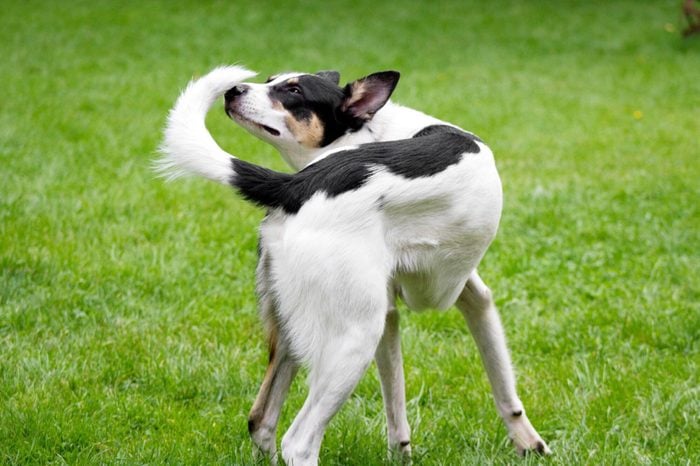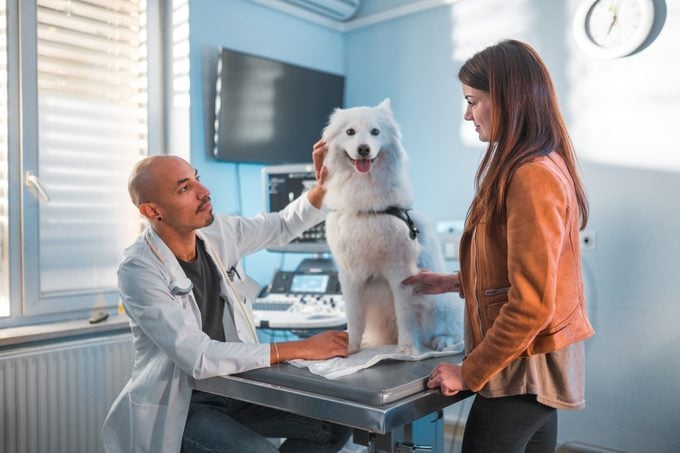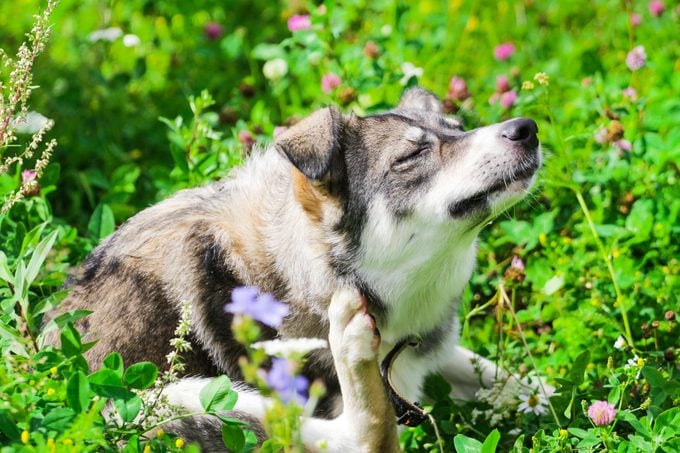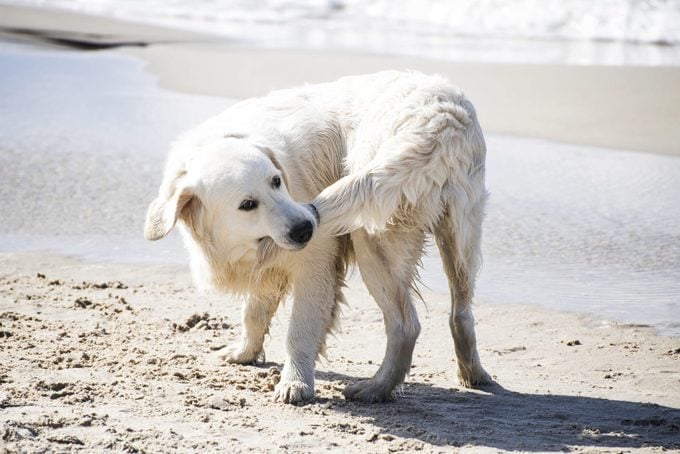Why Do Dogs Chase Their Tails? 8 Reasons for This Behavior
Updated: Apr. 23, 2024

This behavior may seem alternately adorable and strange to us, but dogs have very good reasons why they chase their tails
There are few things cuter than watching your dog discover its marvelous tail … and then chase it and try to catch it, running in circles until you’re both dizzy. But this quirky dog behavior can be confusing too—after all, you have a whole array of dog toys littering your living room, and this is what your dog has chosen to play with?! It can also be concerning if your dog suddenly becomes obsessed with this pastime and won’t stop, no matter what you try. So why do dogs chase their tails?
As a certified professional dog trainer for more than 20 years and the owner of a Newfoundland with a very fluffy tail, I know firsthand about the strange things dogs do—and why they’re so important to understand. Dogs use their tails to communicate how comfortable and confident they are; they can also indicate how your dog is feeling physically.
That said, it’s essential to look at what a dog is doing overall to decode the root of the tail chasing. I have some insight into the behavioral reasons your dog might chase its tail, but I also spoke with veterinarians Lindsay Butzer, DVM, and Lisa Lippman, DVM, to shed light on the medical possibilities as well. Ahead, we will walk you through the main reasons your dog is probably chasing its tail—and what you should do when it happens.
Get Reader’s Digest’s Read Up newsletter for more pets, humor, cleaning, travel, tech and fun facts all week long.
About the experts
Reviewed for accuracy by: Wailani Sung, DVM, a vet with a board certification in veterinary behavioral medicine who owns Bay Area Vet Behavior. Dr. Sung is the co-author of From Fearful to Fear Free: A Positive Program to Free Your Dog from Anxiety, Fears and Phobias. |
Why do dogs chase their tails?
There’s a wide range of reasons why dogs chase their tails, and while some of it is innocuous, some is definitely cause for concern. The key here is to focus on context and frequency. Here’s how to determine what your dog is up to.
1. Playfulness

Let’s start with a fun one first. Most common in puppies and young dogs, especially ones with long, fluffy tails, this type of behavior occurs when dogs suddenly “discover” they have a tail and decide it’s a fun toy to play with. Puppies are learning about their bodies and the world around them, and they use their mouths as part of their exploration. You’ll know that everything is OK because the tail chasing happens when your dog is happy, relaxed and playing, and doesn’t seem distressed.
What you should do: Pull out your phone and take some pictures! Play is important for dogs because it decreases anxiety and increases happiness, and this type of activity, as long as it doesn’t have any other accompanying symptoms (as noted below), is nothing to be concerned about.
2. Happiness
This is similar to playfulness, but it’s worth the extra mention since a lot of people wonder if tail chasing is a sign of doggy happiness. The answer? It definitely can be! Different from simply being playful and entertaining themselves, this version of happiness involves you, their favorite human. In addition to having soft and relaxed body language, happy dogs chasing their tails might also jump up, bark or bring you a toy to encourage playtime.
Chances are, you are also reinforcing this type of tail chasing. If this behavior gets you to put down your phone, laugh and engage with your dog, your dog will likely do it more. My dog was enamored with her tail when she was a puppy, and I thought the behavior was so cute that I taught her how to chase her tail as a cued trick!
What you should do: Play with your dog. Dogs clearly want your attention when they do this, and playing with them will strengthen your bond. While you can teach your dog to chase its tail using a treat, you can also capitalize on your pup’s natural instincts by using a training method known as “capturing.” When your happy dog chases its tail, say a verbal cue of choice like “tail” or “chase,” and reward your dog with a treat. In time, your dog will understand that cue means you want it to chase its tail.
3. Boredom

High-energy dogs that aren’t getting enough enrichment will often chase their tails out of boredom. To determine if this is the case, think about what your dog’s daily routine looks like. Has your dog gotten attention from and playtime with you? Has it had an opportunity to go outside for a walk or to run and play? If not, your dog may be telling you it needs more exercise and attention.
If you’re not sure whether boredom is to blame, engage your dog in a fun game or take a walk together, providing plenty of opportunities to sniff. (Sniffing is highly rewarding for dogs and provides a lot of mental engagement.) If your dog stops chasing its tail after this, that’s a good indicator it was using the behavior for entertainment and needs more outlets to release energy.
What you should do: Make sure your dog’s physical and mental needs are being met. Set your alarm early so you can take a longer walk before leaving for work. Or if you’re heading out after work, go home first to give your dog attention and exercise. If you’re going to be away for a long day, consider hiring a dog walker.
You should also stock up on mentally stimulating games and toys to keep boredom at bay. I highly recommend durable treat-stuffed toys, like Kongs, which can be filled with food, peanut butter and other treats. Freeze them to create a longer-lasting option for your pup to lick, chew and work to get the food out.
4. Pain or trauma to the tail
“If your dog doesn’t normally chase its tail for fun and is now gnawing at it, this means your dog is uncomfortable,” Dr. Butzer says. “They are not going after their tail for fun or to be cute—there is something bothering them.” This can be anything from a skin infection (a common one, a hot spot, is caused by bug bites) to a tail fracture, and even the smallest trauma can lead to big problems. That’s because the tail has very little skin, says Dr. Butzer, so if a dog chews its tail open, vertebrae and nerves can be exposed. This can be difficult to heal and lead to serious infections and, in the most extreme cases, a tail amputation.
What you should do: Take a look at your dog’s tail, and if you notice any redness, scaly patches of skin or bleeding, call your veterinarian immediately. The same goes if your dog’s tail seems particularly sensitive but you’re not noticing the aforementioned symptoms; it’s best to address the problem now, before it gets noticeably worse.
5. Medical issues

When tail chasing is accompanied by biting, it’s definite cause for concern—and there may be something other than tail trauma at play here. Other concerning symptoms, according to Dr. Lippman, include lethargy, loss of appetite, vomiting, diarrhea or dragging their hindquarters. Issues could be something minor like anal-gland impaction, which causes a dog to bite at the base of its tail to try to alleviate the discomfort, to a more serious condition like neurofibroma, a benign nerve-sheath tumor on the base of the tail. The latter can cause itchiness and an odd tingling sensation all the way down the spine, says Dr. Butzer, and can lead to a dog “neurotically” biting its tail.
What you should do: See a vet to determine the cause of this behavior. If you believe that anal-gland impaction is the issue (scooting is the telltale sign), a groomer can help if you don’t want to do this yourself or make a trip to the vet.
6. Fleas
The base of the tail is a common place for fleas to bite, and this can lead to a dog chasing or biting its tail in an attempt to alleviate the itchiness. It takes only one flea bite to make a dog very itchy and uncomfortable, and according to Dr. Butzer, fleas are one of the top two reasons dogs exhibiting tail chasing and biting end up in her office. (The other is a skin infection, FYI.) To determine if this is the issue, inspect the base of your dog’s tail (or if your dog has long fur, use a flea comb to section fur in the area) and look for fleas or little dark specks. Sometimes called “flea dirt,” this is the feces of fleas and often the clearest sign that a dog is struggling with fleas even if you don’t see any crawling around.
What you should do: If you find fleas or evidence of fleas on your dog, talk with your veterinarian about the best flea shampoo. And to ward off fleas in the future, make sure your dog is up to date with parasite-prevention medication.
7. Allergies

Just like people, dogs can experience allergies to a wide variety of things. Common environmental triggers include pollen, grass and mold, and dogs with sensitivities to these things may also bite at their feet and other body parts exposed to the allergens. Food allergies can also cause overall itchiness, including on the tail.
What you should do: If you notice any skin irritation, make an appointment with your dog’s veterinarian. Your vet will examine your dog’s skin, check for infection and provide treatment as needed. Additionally, the vet may also perform allergy tests to determine what your dog is allergic to so you can take the necessary steps to prevent an allergic reaction in the future.
8. Anxiety
For dogs struggling with anxiety, tail chasing can become a compulsive behavior. According to a study published in Frontiers in Veterinary Science in 2022, the root of this issue is a psychiatric disorder that often becomes noticeable when dogs are between 6 and 12 months of age. And it can be a vicious cycle, with the behavior causing even more tail biting and anxiety, as well as self-inflicted trauma to the tail.
What you should do: Consult a vet, behaviorist or trainer to determine if anxiety is the cause of this behavior. As a dog trainer, I look for what triggers the obsessive behavior, because once you identify it, you can avoid the stressor and lessen the dog’s anxiety naturally. This might entail putting up curtains so your dog can’t see trucks driving down the street, or playing music to muffle certain sounds. You can also start to counter-condition your dog by pairing a distant trigger with something positive—like a high-value treat or play reward coupled with praise. Over time, this can help your dog build new and positive associations with the trigger.
If your dog is already triggered, try to create distance from what your dog finds upsetting and then redirect your dog to a different activity. For example, see if you can engage your pup with a hollow toy stuffed with peanut butter.
Why do dogs chew their tails?
Dogs chew on their tails when they are physically uncomfortable or struggling with emotional regulation. Unlike tail chasing, tail chewing is always something to be concerned about and seek attention for, since it’s very easy for dogs to cause injuries to their tail by chewing at it. They also won’t stop doing it until the root issue has been addressed. (See above for the possibilities.)
If you see your dog chewing on its tail, try to interrupt the behavior right away. Then check your dog’s tail closely for any injuries or skin irritations. If you notice a problem or if your dog continues to try to chew its tail, schedule an appointment with your veterinarian.
Do dogs know it’s their tail when they chase it?

Yes, most adult dogs are aware that they are chasing their own tail! There is a common misconception that dogs who chase their tails must be dumb, but this couldn’t be further from the truth. Dogs are extremely intelligent and naturally playful, and it’s not that they don’t know the tail belongs to them—they just don’t care! Dogs live to play, and if they find a good toy (even if it’s attached to them), they are going to keep playing with it.
Puppies, however, are a different story since they are still learning. They may see their tail moving, be curious and be motivated to chase it because of their natural instinct to play. So young puppies may not fully understand that the tail they are chasing is their own—until they catch it, that is!
Do some dog breeds chase their tails more than others?
Breeds especially prone to chasing their tails at all stages of life include border collies, German shepherds, golden retrievers, Labrador retrievers and Cardigan Welsh corgis. This is due to their high energy levels and longer, fluffier tails. (More fluff, more fun!) I’ve personally noticed this more in herding breeds that aren’t getting enough exercise and engagement. Mixed-breed dogs and any dogs with long wispy tails that can see their tail out of the corner of their eyes are also more prone to this behavior, says Dr. Butzer.
Should you let a dog chase its tail?
If your dog is just playing, yes! It is very normal for a dog to dog occasionally chase its tail. However, you should always keep a close eye on your dog to make sure this behavior isn’t overly frequent, obsessive or accompanied by physical symptoms of pain or other distress. And if your dog catches its tail and starts biting it, you should interrupt the behavior and schedule an appointment with a vet if it happens again. Dr. Lippman adds that pet parents should never hesitate to bring concerns to their dog’s veterinarian for examination, diagnosis and treatment.
Why trust us
At Reader’s Digest, we’re committed to producing high-quality content by writers with expertise and experience in their field in consultation with relevant, qualified experts. For this piece on why dogs chase their tails, Sassafras Lowery, CPDT-KA, CTDI, tapped her experience as a certified professional dog trainer, and then Wailani Sung, DVM, DACVB, PhD, a veterinarian specializing in behavioral medicine and the co-author of From Fearful to Fear Free: A Positive Program to Free Your Dog from Anxiety, Fears and Phobias, gave it a rigorous review to ensure that all information is accurate and offers the best possible advice to readers. We verify all facts and data, back them with credible sourcing and revisit them over time to ensure they remain accurate and up to date. Read more about our team, our contributors and our editorial policies.
Sources:
- Lisa Lippman, DVM, veterinarian at Bond Vet; email interview, Jan. 31, 2024
- Lindsay Butzer, DVM, veterinarian and YouTuber; email interview, Feb. 2, 2024
- Frontiers in Veterinary Science: “An Interdisciplinary Approach for Compulsive Behavior in Dogs: A Case Report”




